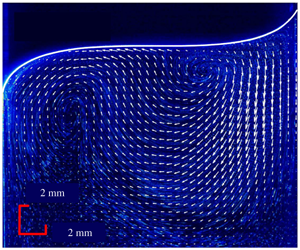Article contents
Streaming controlled by meniscus shape
Published online by Cambridge University Press: 12 May 2020
Abstract

Surface waves called meniscus waves often appear in systems that are close to the capillary length scale. Since the meniscus shape determines the form of the meniscus waves, the resulting streaming circulation has features distinct from those caused by other capillary–gravity waves recently reported in the literature. In the present study, we produce symmetric and antisymmetric meniscus shapes by controlling boundary wettability and excite meniscus waves by oscillating the meniscus vertically. The symmetric and antisymmetric configurations produce different surface capillary–gravity wave modes and streaming flow structures. The root-mean-square speed of the streaming circulation increases with the second power of the forcing amplitude in both configurations. The flow symmetry of streaming circulation is retained under the symmetric meniscus, while it is lost under the antisymmetric meniscus. The streaming circulation pattern beneath the meniscus observed in our experiments is qualitatively explained using the method introduced by Nicolás & Vega (Fluid Dyn. Res., vol. 32 (4), 2003, pp. 119–139) and Gordillo & Mujica (J. Fluid Mech., vol. 754, 2014, pp. 590–604).
- Type
- JFM Papers
- Information
- Copyright
- © The Author(s), 2020. Published by Cambridge University Press
References
Huang et al. supplementary movie 1
Experimental movies for the streaming circulations produced with a symmetric meniscus (movie 1.avi). It corresponds to Fig.3 of ‘Streaming controlled by meniscus shape’ by Y. Huang, C.P. Wolfe, J. Zhang and J.-Q. Zhong. The driving frequency is f0=8 Hz. The driving amplitude is a0=0.2g0. When played at 10 frames per second, the movie runs at 0.8 times real speed.
Huang et al. supplementary movie 2
Experimental movies for the streaming circulations produced with an antisymmetric meniscus (movie 2.avi). It corresponds to Fig.4 of ‘Streaming controlled by meniscus shape’ by Y. Huang, C.P. Wolfe, J. Zhang and J.-Q. Zhong. The driving frequency is f0=8 Hz. The driving amplitude is a0=0.2g0. When played at 10 frames per second, the movie runs at 0.8 times real speed.
- 8
- Cited by


